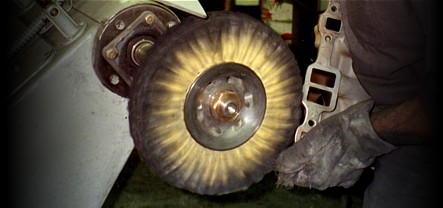


Demand quality, expect the best!!!
Picture if you will, a reflective mountain range, with the light reflecting into itself, this would represent a poorly polished, or ‘hand rubbed’ finish. When properly polished, this mountain range will be virtually flat, with the light reflecting back off the surface. The smoother the surface, the more color and clarity there is in the finish. Mechanical finishing is best way to achieve the smoothest surface with the very finest of the finishing buff marks, reflecting light just scattered enough to give the finish a beautiful glow
There are other variables that control the best possible finish. Usually it is the type of manufacturing (example: billet, sand cast, die cast, injection molding,). Billet is usually a tight-grained alloy that polishes to an incredible level of clarity and color, while on the other hand, sand casting and injection molding seem to be a very open, porous grain alloy, while still looking pretty phenomenal, it doesn’t come out quite as perfect.
The other would be the quality control during the manufacturing process- gassing (pits) and contamination (sand and impurities) being the biggest problem. Often with sand casting, there are small pits from the alloy gassing during the casting. Occasionally, there are actual small craters in the casting too, if these appear, some can be sanded out, however, under that surface are usually other casting blems that show up the same. The only way to deal with the pitting is to not lay into with a buff, causing pits to drag out, exaggerating the blemish. Buffing needs to be done gently, from multiple directions, leaving a uniform blemish, that is not a visual distraction.
Properly polished alloy will have a tendency to stay shinier longer, and when maintenance is done, better results are realized. A poor polish job will require more maintenance, and result will be less than spectacular.
Also realize, show quality can be disproportional in cost to a lackluster polish job. While all polishing is labor intensive, a poor quality job, will hide a multitude of sins, including sanding marks, rippling, and prominent buff marks. A near perfect finish will expose those sins, requiring addition labor, and very specific attention to detail all throughout the polishing process-like removing each previous grit’s sanding marks, and not putting in ripples into the surface.
The exceptional results of true show quality work are worth the additional expense. How can one justify installing cut-rate quality polished trim, when spending 10k on a paint job, or building a custom motorcycle with polishing that is absolutely lifeless?
True show quality polishing, reflects the attention to detail you have put into your project!